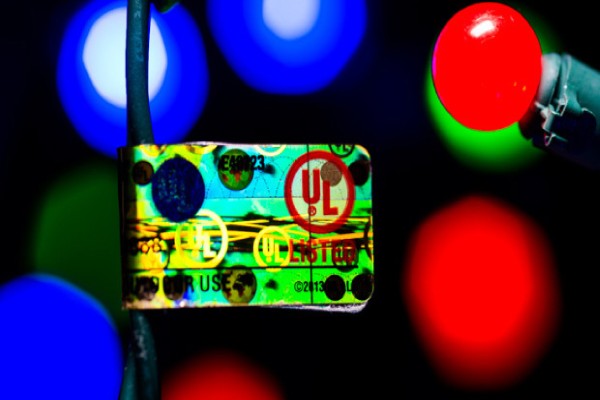The holiday season is a time when many homes feature a sparkling Christmas tree decked with ornaments filled underneath with presents and more decorations.
But to Anthony Tassone, the principal engineer of the Seasonal Lighting categories at UL’s Melville, N.Y., site, that festive scene is one filled with potential risks. Part of Tassone’s responsibilities at UL is to make sure a room full of holiday decorations looks bright and stays festive with a minimum risk of producing fire and electric shock.
The UL 588 “Seasonal and Holiday Decorative Products” standard governs the safety of seasonal products ranging from regular lighting strings to any sort of holiday-themed sculptures, inflatable objects and ornaments. Traditionally, most of the products use a 120 V power supply but the last few years there has been a steady increase in the number of products powered by solar cells or batteries, Tassone said.
Although the public’s perception is that these products are “safe” there is still a potential risk of fire based on the current available and the size of wiring used on the products in the market. Even though UL 588 has requirements for these products, there are only a few UL listed solar- or battery-powered products in the market.
“During the holiday season there’s a lot of decorations, such as tree skirts, and paper wrapped gifts which could be easily ignited. Three D batteries can produce a limited short circuit current, so the size of the wiring and materials used are important in order to decrease the risk of fire,” Tassone said.
 |
|
CPSC and UL helps to to ensure holiday lights has a minimum risk of fire and electric shock. (photograph courtesy of UL) |
One issue that UL has found in the market is the use of undersize wiring on lighting strings (26 or 28 gauge) on unauthorized products when 22 gauge should be the smallest size used.
To combat this, the U.S. Consumer Product Safety Commission (CPSC) is insisting holiday products sold in the United States conform to UL 588. In a letter distributed July 14 to manufacturers, importers and retailers of holiday lights, the CPSC urged them to make sure lights and decorative outfits they import, manufacture, distribute or sell adhere to the UL 588 standard. The letter states that the CPSC has the authority to “seek detention, seizure, destruction, or recall” of holiday lighting products that do not meet the UL standard.
From 1980 through 1996, CPSC officials said 202 deaths and 753 nonfatal injuries involving seasonal lights that were fire or shock hazards. This is an average of almost 12 deaths and more than 44 injuries a year.
CPSC officials approached UL in 1995, Tassone said, requesting that the standard be reviewed to address the issues in the market.
The 1997 revision of UL 588 standard included new requirements for proper strain relief in lamp holders and attachment plugs, increased minimum wire sizes and thicker insulation. The results have been dramatic. From 2000 to 2013, average injuries were cut in half and the average death rate dropped to three deaths a year – a 75 percent reduction.
Tassone said UL’s commitment to maintaining its standard begins when a product leaves the lab with the UL Mark. Since 1999, UL has run extensive market surveys to help make sure products sold on store shelves comply with the requirements. Tassone said during this year’s UL market survey, UL teams purchased over 100 samples from a variety of retailers – from the “mom-and-pops” to the largest retail chains.
“We select samples and we test them, and if they fail, it’s called a ‘strike,’” Tassone said. At that time, a public notice can be issued regarding the failure and the factory is required to suspend use of the UL Mark until the cause of the failure is found and corrected. If a product is issued two strikes in a two-year period, that factory is unable to place UL Marks on those products.
Also, the CPSC is copied on the public notices and, in the recent years, has issued product recalls after conducting their own investigation. As the CPSC letter states, manufacturers face financial penalties for non-compliance.
Shoppers should not be too worried about buying holiday decorations, Tassone said, because the combined efforts of UL and CPSC have meant that the compliance rate in the U.S. market is high.
“The standard and ongoing market surveillance has made a huge impact,” Tassone said.





 CN
TW
EN
CN
TW
EN






